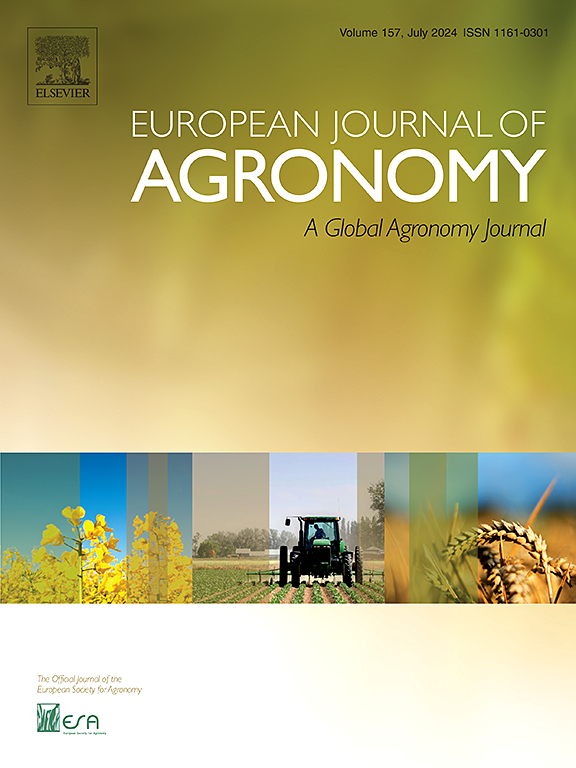Optimization of agronomic management positively affects soil GHG emission: Viable solutions of mitigation in moist and dry Mediterranean climate zones
IF 4.5
1区 农林科学
Q1 AGRONOMY
引用次数: 0
Abstract
This study assesses the greenhouse gases (GHG) mitigation potential of two cropping systems under the diverse pedoclimatic conditions of two sites in Northern and Southern Italy, belonging to moist and dry climate zones, respectively. The two cropping systems, implemented at field scale in silty-clay-loam soils, were an optimized cropping system (ECS), designed and managed to be more efficient in the use of nitrogen and in the conservation of soil organic carbon (SOC), and a conventional system (CCS). N2O and CO2 soil fluxes were measured daily over three to four years using automatic stations comprising eight non-steady-state chambers per site. The ARMOSA model, calibrated and validated with measured data, provided reliable simulations of GHG fluxes and crop yields, aiding environmental impact assessments. In the Northern moist site, the ECS showed a significant GHG mitigation effect, serving as a GHG sink due to reduced N2O emissions (N input-scaled emission: 0.0030 kg N-N2O kg N−1). Conversely, the CCS, despite its higher productivity and SOC storage, emitted more N2O (N input-scaled emissions 0.0051 kg N-N2O kg N−1), making it a GHG source. In the moist site ECS had an effective mitigation potential compared with CCS, while in the Southern dry site both systems had lower GHG emissions than at the moist site, due to the reduced N rates (-27 % in CCS, −33 % in ECS), thus resulting as GHG sinks. This study underscores the relevance of agronomic mitigation practices, like leguminous crops integration and optimized nitrogen management where GHG emission are fostered by site-specific pedoclimatic conditions.
优化农艺管理对土壤温室气体排放产生积极影响:地中海潮湿和干燥气候区可行的缓解办法
本研究评估了意大利北部和南部两个地点不同气候条件下两种种植制度的温室气体(GHG)减排潜力,分别属于湿润和干燥气候区。在粉质粘土壤土中实施的两种种植制度是一种优化的种植制度(ECS),设计和管理更有效地利用氮和保持土壤有机碳(SOC),以及一种传统的种植制度(CCS)。在三到四年的时间里,每天使用自动站测量N2O和CO2的土壤通量,每个站点包括八个非稳态室。ARMOSA模型经过测量数据的校准和验证,提供了温室气体通量和作物产量的可靠模拟,有助于环境影响评估。在北部湿润站点,ECS表现出显著的温室气体减缓效应,由于减少了N2O排放(N投入尺度排放:0.0030 kg N-N2O kg N- 1),因此具有温室气体汇的作用。相反,CCS尽管具有更高的生产力和SOC存储,但排放了更多的N2O (N投入比例排放量0.0051 kg N-N2O kg N- 1),使其成为温室气体源。与CCS相比,湿润站点的ECS具有有效的减缓潜力,而在南部干燥站点,由于氮率降低(CCS为-27 %,ECS为- 33 %),这两个系统的温室气体排放量都低于湿润站点,从而导致温室气体汇。本研究强调了农艺缓解措施的相关性,如豆科作物整合和优化氮管理,其中温室气体排放由特定地点的气候条件促进。
本文章由计算机程序翻译,如有差异,请以英文原文为准。
求助全文
约1分钟内获得全文
求助全文
来源期刊

European Journal of Agronomy
农林科学-农艺学
CiteScore
8.30
自引率
7.70%
发文量
187
审稿时长
4.5 months
期刊介绍:
The European Journal of Agronomy, the official journal of the European Society for Agronomy, publishes original research papers reporting experimental and theoretical contributions to field-based agronomy and crop science. The journal will consider research at the field level for agricultural, horticultural and tree crops, that uses comprehensive and explanatory approaches. The EJA covers the following topics:
crop physiology
crop production and management including irrigation, fertilization and soil management
agroclimatology and modelling
plant-soil relationships
crop quality and post-harvest physiology
farming and cropping systems
agroecosystems and the environment
crop-weed interactions and management
organic farming
horticultural crops
papers from the European Society for Agronomy bi-annual meetings
In determining the suitability of submitted articles for publication, particular scrutiny is placed on the degree of novelty and significance of the research and the extent to which it adds to existing knowledge in agronomy.
 求助内容:
求助内容: 应助结果提醒方式:
应助结果提醒方式:


